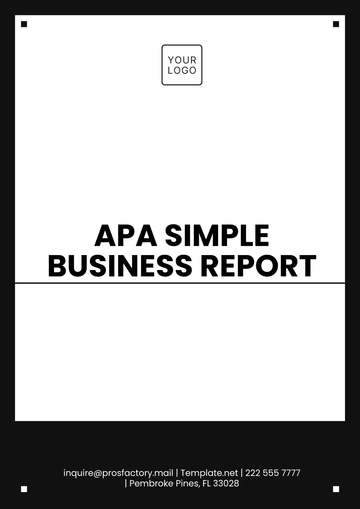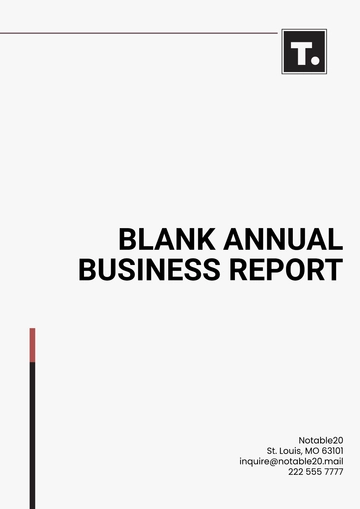Free Business Acquisition Report

Prepared by: [Your Name]
Date: January 1, 2050
Company Name: [Your Company Name]
Acquired Company Name: MaraTime
I. Executive Summary
This section summarizes the key points of the business acquisition, including the purpose, expected outcomes, and the value of the deal for both parties involved.
Acquisition Type: Full acquisition (100% ownership)
Acquisition Value: $1.5 billion
Target Company Overview: MaraTime specializes in AI-driven automation software for industrial applications, with a strong presence in North America and Europe.
Rationale: The acquisition aims to expand [Your Company Name]’s AI capabilities, integrate MaraTime’s cutting-edge automation solutions, and enhance overall growth in the global market.
II. Background Information
Acquiring Company Overview: [Your Company Name] is a global leader in technological innovations, specializing in artificial intelligence, robotics, and smart manufacturing solutions. With a revenue of $5 billion in 2049 and a strong presence in North America and Asia, we are looking to broaden our portfolio and leadership in AI technology.
Target Company Overview: MaraTime has been at the forefront of AI-driven automation in the industrial sector. With annual revenues of $300 million and a workforce of 1,000 employees, the company operates across major markets in North America, Europe, and parts of Asia.
III. Objectives of the Acquisition
The strategic goals for this acquisition include:
Market Expansion: Gain access to new geographical markets, especially in Europe and Asia, where MaraTime has strong distribution networks.
Technology Integration: Integrate MaraTime's AI-driven software into [Your Company Name]’s product line to strengthen our offerings in smart manufacturing and automation.
Revenue Growth: Leverage combined resources to capture more market share, particularly in the emerging markets of Asia.
Talent Acquisition: Onboard MaraTime’s top engineers and researchers to fuel future innovations in AI and automation.
IV. Due Diligence Findings
The due diligence process involved a comprehensive review of the financial, operational, legal, and market factors of MaraTime. Key findings include:
Financial Health: MaraTime is financially stable, with annual revenues of $300 million and a profit margin of 12%. Their EBITDA for 2049 was $36 million. However, there are some risks associated with their exposure to fluctuating currency exchange rates in international markets.
Legal Considerations: All major legal aspects, including intellectual property rights for their AI software, have been reviewed. There are no outstanding lawsuits or regulatory concerns. A few minor intellectual property disputes are currently being settled in European courts but are not expected to impact the acquisition.
Market Position: MaraTime holds a strong position in the AI automation market and is considered a market leader in industrial AI solutions. They have a loyal customer base, with notable clients like Siemens, GE, and Toyota.
Operational Strengths and Weaknesses: MaraTime has an impressive research and development division but faces challenges in scaling operations across global markets, particularly in Asia, where their distribution channels are less developed.
V. Valuation and Financial Terms
Valuation Method: The valuation was conducted using a Discounted Cash Flow (DCF) analysis, along with a comparable company analysis to assess the market value.
Purchase Price: The agreed purchase price is $1.5 billion, with an anticipated closing date of March 15, 2050.
Payment Structure: The deal will be financed with 60% cash ($900 million) and 40% stock in [Your Company Name] valued at $600 million.
VI. Integration Strategy
The integration of MaraTime will be managed through the following phases:
Phase 1 – Pre-Integration Planning: Establish an integration team by March 20, 2050, to define roles, responsibilities, and a detailed integration timeline.
Phase 2 – Operational Integration: Align operations starting April 1, 2050, with a focus on merging technology platforms and optimizing business processes.
Phase 3 – Cultural Integration: Foster a collaborative culture by introducing joint team-building initiatives and leadership exchanges between the companies starting in Q2 2050.
Phase 4 – Ongoing Monitoring and Support: Track integration progress monthly and resolve any challenges. Quarterly reviews will be conducted throughout 2050 and beyond to ensure smooth execution.
VII. Risks and Mitigation Plans
The potential risks identified in the acquisition process include:
Cultural Clash: The different corporate cultures may create integration challenges. Mitigation: Implement a strong change management plan and foster open communication between teams.
Customer Retention: Maintaining customer relationships is critical during the transition. Mitigation: A robust communication plan will be implemented to reassure customers about the stability and benefits of the acquisition.
Regulatory Approval: The acquisition requires regulatory approval in both North America and Europe. Mitigation: Legal and compliance teams will submit the required documentation by February 1, 2050, and anticipate approval by March 1, 2050.
VIII. Conclusion
The acquisition of MaraTime is a strategic move that will strengthen [Your Company Name].'s position as a leader in AI and automation technologies. The integration of MaraTime’s technology and expertise will enable [Your Company Name] to deliver innovative solutions, accelerate revenue growth, and expand into new markets. With effective due diligence and a well-structured integration plan, this acquisition is expected to significantly enhance long-term value.
IX. Recommendations
Based on the analysis, the following actions are recommended:
Approve the Acquisition: Proceed with the acquisition as outlined.
Initiate Integration Plan: Begin the integration process as soon as the deal is closed in mid-March 2050.
Monitor Progress: Ensure continuous tracking and monitoring of integration phases, making adjustments as needed.
- 100% Customizable, free editor
- Access 1 Million+ Templates, photo’s & graphics
- Download or share as a template
- Click and replace photos, graphics, text, backgrounds
- Resize, crop, AI write & more
- Access advanced editor
Discover the Business Acquisition Report Template from Template.net. This fully customizable and editable template is designed for seamless integration into your workflow. Editable in our AI Editor Tool, it ensures a professional, polished report every time. Elevate your business documentation effortlessly with this versatile, user-friendly template. Unlock your potential today with Template.net.
You may also like
- Sales Report
- Daily Report
- Project Report
- Business Report
- Weekly Report
- Incident Report
- Annual Report
- Report Layout
- Report Design
- Progress Report
- Marketing Report
- Company Report
- Monthly Report
- Audit Report
- Status Report
- School Report
- Reports Hr
- Management Report
- Project Status Report
- Handover Report
- Health And Safety Report
- Restaurant Report
- Construction Report
- Research Report
- Evaluation Report
- Investigation Report
- Employee Report
- Advertising Report
- Weekly Status Report
- Project Management Report
- Finance Report
- Service Report
- Technical Report
- Meeting Report
- Quarterly Report
- Inspection Report
- Medical Report
- Test Report
- Summary Report
- Inventory Report
- Valuation Report
- Operations Report
- Payroll Report
- Training Report
- Job Report
- Case Report
- Performance Report
- Board Report
- Internal Audit Report
- Student Report
- Monthly Management Report
- Small Business Report
- Accident Report
- Call Center Report
- Activity Report
- IT and Software Report
- Internship Report
- Visit Report
- Product Report
- Book Report
- Property Report
- Recruitment Report
- University Report
- Event Report
- SEO Report
- Conference Report
- Narrative Report
- Nursing Home Report
- Preschool Report
- Call Report
- Customer Report
- Employee Incident Report
- Accomplishment Report
- Social Media Report
- Work From Home Report
- Security Report
- Damage Report
- Quality Report
- Internal Report
- Nurse Report
- Real Estate Report
- Hotel Report
- Equipment Report
- Credit Report
- Field Report
- Non Profit Report
- Maintenance Report
- News Report
- Survey Report
- Executive Report
- Law Firm Report
- Advertising Agency Report
- Interior Design Report
- Travel Agency Report
- Stock Report
- Salon Report
- Bug Report
- Workplace Report
- Action Report
- Investor Report
- Cleaning Services Report
- Consulting Report
- Freelancer Report
- Site Visit Report
- Trip Report
- Classroom Observation Report
- Vehicle Report
- Final Report
- Software Report





























